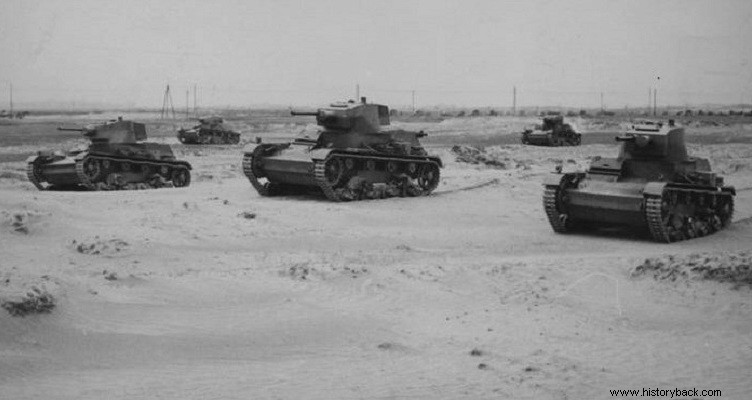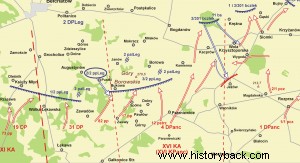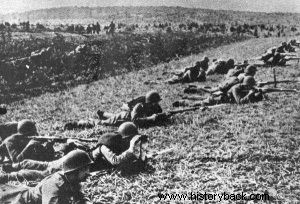
The Battle of Borowa Gora was a series of skirmishes that took place on the hill range of the same name in the greater area of Locs (Wuts in Polish) in central Poland, west of Piotruków Trybunaski.
This battle is one of the standouts in history as the attackers were so overwhelmingly superior in numbers, firepower, agility, tanks and air power that the defenders, logically, should have been pulverized in the first few hours of the battle.
Nevertheless, the defenders endured three whole days fighting more than heroically. As the Germans had invaded Poland the Łódź Army's Operation Piotruków Detachment, under Brigadier General Viktor Tome, commanded the 2nd Infantry Regiment (IP) of the Polish Legion to defend the 25 km long sector of Rospasa, 55 km south of Lochs.
The regiment belonged to the 2nd Infantry Division (IP) of the Polish Legion (honorary title derived from the Polish legion of WWI and the war against the Soviets) and commanded by Colonel Ludwik Cieszewski.
The regiment had three infantry battalions, a reconnaissance platoon, an anti-tank company, a scout platoon, an escort gun platoon, a chemical warfare platoon and a relay platoon. Each battalion had a command platoon, three rifle companies and a heavy weapons company with 12 machine guns and two 81mm mortars.
In total the SP nine 37mm Bofors anti-tank guns, 29 anti-tank rifles, two 75mm light guns, 27 46mm light mortars, six 81mm mortars, 36 machine guns and the corresponding machine guns.
This force was up against an entire German Army Corps, the XVI SS, under General Erich Heppner. The SS belonged to the German 10th Army and had the 1st Panzer Division (Panzer Division), the 4th Panzer Division, the 14th Panzer Division and the 31st Panzer Division. The Lodz Army commander, Major General Julius Rommel, reinforced the 2nd SPL at the last minute with Major Edmund Karpov's 301st Light Tank Division, which had 47 tanks.
Cisefki was ordered to hold certain positions until 4 September when, according to plans, a major Polish counterattack would be launched. The center of gravity of the Polish defensive line was the hills of Borova Gora. The 2nd SPL began manning the site – the extent of which would normally have required a strength of two divisions rather than a reinforced regiment, on the night of 2/3 September.
The Germans are coming
The Poles had barely organized the site when, at 13.00 on the 3rd of September, strong German infantry and tank forces appeared before them, while the German planes bombed relentlessly, completely undisturbed.
At 15.00 the Germans rushed out confident of their sure victory. By afternoon the 1st Infantry Division had captured Rospasa, on the Polish right, but the Poles had not had their last word. Polish counterattack forced them to retreat. At the same time on the hills of Borofa Gora the 4th BA stopped against the courage of the 3rd Battalion of the 2nd SPL under Major Zelasovsky!
It was a development that no one could imagine. A pro-extended Polish regiment repulsed two entire German tank divisions closely supported by air! It was a feat that incredibly honors the courage and patriotism of Polish soldiers.
New attack
On the morning of September 4, the Germans repeated the attack, throwing the 31st MP into the battle. But this attack was also repelled. At the same time the two German tank divisions rushed out again. The 1st Infantry Division again attacked Rospasa and the 4th Infantry Division concentrated against the 3rd Battalion again. By afternoon the entire Polish front was literally burning.
Nevertheless, the heroic Poles held on. The battle continued throughout the night and with the first light of September 5th the Poles had to face the German aircraft again . The battle nevertheless continued. But seeing that there was no hope, Chisevsky ordered a retreat. However, certain sections of it continued to fight with fanaticism until September 6.
The battle of the Polish tanks
As mentioned the 301st Light Tank Brigade of major Karpov with 47 operational tanks 7TP, had been assigned to the 2nd SPL. The division, (also known as the 2nd Tank Division) took over the coverage of the right wing of the 2nd SPL and was facing the 4th MPa.
On September 4, two Polish tank companies counterattacked against the Germans and, with the loss of one tank, destroyed six tanks and four armored vehicles of the 1st Infantry Division. The next day all 46 Polish tanks attacked again, west, against the 4th Army this time.
The 2nd Division attacked a German motorized phalanx supported by tanks and armor and inflicted heavy casualties. The Germans lost 15 tanks and armored vehicles and many trucks carrying infantry and supplies. The Poles lost five tanks while another two were damaged.
Nevertheless, the Poles were forced to retreat due to the numerical superiority of the enemies. After the battle the 301st Division also retreated. During the retreat the unit suffered heavy losses. Only one ili managed to retreat east fighting until the tanks were immobilized or destroyed. The survivors fled to the still neutral Hungary.
German losses were significant. The attacks against the 2nd SPL alone cost them 650 dead and 540 wounded. Unfortunately, German losses from the 301st Division are not known. As for the 2nd SPL it had total losses of 663 men, while the losses of the 301st Division were small.
The Poles had again fought well. They were defeated only by the enormous numerical and physical superiority of the opponent.


